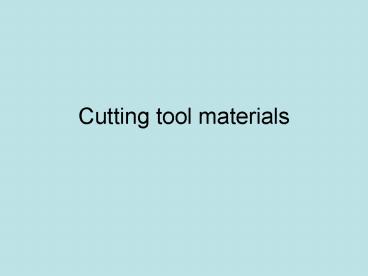Cutting tool materials - PowerPoint PPT Presentation
1 / 25
Title:
Cutting tool materials
Description:
Cutting tool used during the industrial revolution in 1800 A.D ... Chemical inertness. Wear resistance. Al203. Ceramic Cutting Tool. Brittle. Nowadays used extensively ... – PowerPoint PPT presentation
Number of Views:3866
Avg rating:3.0/5.0
Title: Cutting tool materials
1
Cutting tool materials
2
History of cutting tool materials
- Cutting tool used during the industrial
revolution in 1800 A.D - First cutting tool was cast using crucible method
(1740) and slight hardened by H.T. - 1868 R. Mushet found by adding Tungsten we can
increase hardness and tool life ( Air Quenching)
3
History of Cutting tools
- F.W.Taylor in Pennsylvania did the most basic
research in metal cutting between 1880-1905 - Invented high speed steel (better H.T. process)
- Better alloy
- Tungsten Carbide was first synthesized in 1890.
- Took 3 decades before we got Cemented carbide
- First used in Germany
- Sintering technology was invented
4
Cutting tool materials
- Selection of cutting tool materials is very
important - What properties should cutting tools have
- Hardness at elevated temperatures
- Toughness so that impact forces on the tool can
be taken - Wear resistance
- Chemical stability
5
Types of tool materials
- Carbon medium alloy steel
- High speed steel (HSS)
- Cast cobalt alloys
- Carbides
- Coated tools
- Ceramics
- Cubic boron nitride
- invented by GE in 1969
- Silicon nitride
- Diamond
6
High Speed Steel (HSS)
- Early 1900s
- Very highly used alloy steel
- Can be hardened to various depths
- Good wear resistance
- High toughness
- Good for positive rake angle tools.
- Two basic types of HSS
- Molybdenum ( M Series)
- Tungsten (T Series)
7
High Speed Steel
- T Series
- 12 18 Tungsten
- Chromium, vanadium etc.
- M Series
- 10 Molybdenum
- Chromium, Vanadium, Tungsten, Cobalt
- Better abrasion resistance
- Less expensive
- Less distortion
- 95 of HSS used is M series
8
High Speed Steel
- Manufacturing
- Cast
- Powder metallurgy
- Applications
- Taps
- Gear cutters
- drills
9
Cast Cobalt (Stellite tool)
- 38 53 Cobalt
- 30 33 Chromium
- 10 20 Tungsten
- High hardness (58-64 HRC)
- Good wear resistance
- High temperature hardness
- No Toughness
- not suitable for intermittent cutting
- Good for deep boring, continuous turning ( better
than HSS)
10
Carbides
- Most HSS and Cast Alloy have very low high
temperature hardness - Low life for high speed machining
- Carbides
- High temp Hardness
- Low thermal expansion
- High modulus of elasticity
- Tungsten Carbide (W-C)
- Used for cutting non ferrous abrasive and metal
cast iron - Tungsten Carbide particles are bonded in Cobalt
matrix
11
- Cermet (Titanium Carbide)
- Invented in 1950
- used since 1970
- Coated Carbide
- Made of WC Co TiC - TiN
- 3 4 coatings of Al2O3
12
- Particles sized 1- 5 mm are pressed and sintered
into desired shapes ( of Co may vary) - W-C is also compounded, sometimes with Titanium
and Tantalum to improve hot hardness and crater
wear - Titanium Carbide
- Ti-C has Ni-Mb matrix
- Good wear resistance and poor toughness
- Good for machining steel
- Higher speed than W-C
13
- Stiffness of the machine is important
- Low feed, low speed and chatter can cause failure
- Carbide Inserts
- Smaller angle has less strength
- Coated tools
- The coating is 5-10 mm in thickness
- http//www.carbidedepot.com/bbars.asp
14
- Titanium Nitride
- Low friction
- High hardness
- Resistance to high temperature
- Improves life of HSS, carbides
- Ceramics
- High temperature resistance
- Chemical inertness
- Wear resistance
- Al203
15
- Ceramic Cutting Tool
- Brittle
- Nowadays used extensively
16
- Ceramic
- Fine grained , high purity Al203 cold pressed at
high temperature and sintered at high temperature
(white) - Cermets
- 70 Al203 30 T-C
- Very high temperature hardness
- High abrasion resistance
- More chemical stability
- Less tendency for adhesion so less BUE
- Good surface finish while machining steel and CI
- Poor toughness for intermittent cutting
17
- Cubic Boron Nitride
- Next to diamond, the hardest material
- 0.5-1mm polycrystalline cubic boron nitride
- High wear resistance
- But brittle
- Used for machining hardened steel and high
temperature alloys ( Ni for instance)
18
- Silicon Nitride
- Used for super alloys
- Diamond
- Low friction and high wear resistance
- Good cutting edge
- Single crystal diamond are used to machine copper
to a high surface finish - Because they are brittle rake angle has to be low
19
- Polycrystalline diamond tool
- (Compacted) synthesized crystals
- Fused at high temperatures and high pressures
20
(No Transcript)
21
(No Transcript)
22
Tool life curves for various tool materials in
medium and light turning operations as a
function of cutting speed. Note how the curve for
ceramics crosses over the curve for T-C as speed
, hence temperature, increases
Effect of cobalt content in T-C tools over
mechanical properties. Hardness is directly
related to compressive strength and hence,
inversely, with wear
23
Relative time required to machine with various
tool cutting materials, indicating the year the
cutting tool material were first introduced
24
(No Transcript)
25
increasing
increasing
increasing
increasing
increasing
increasing
increasing































